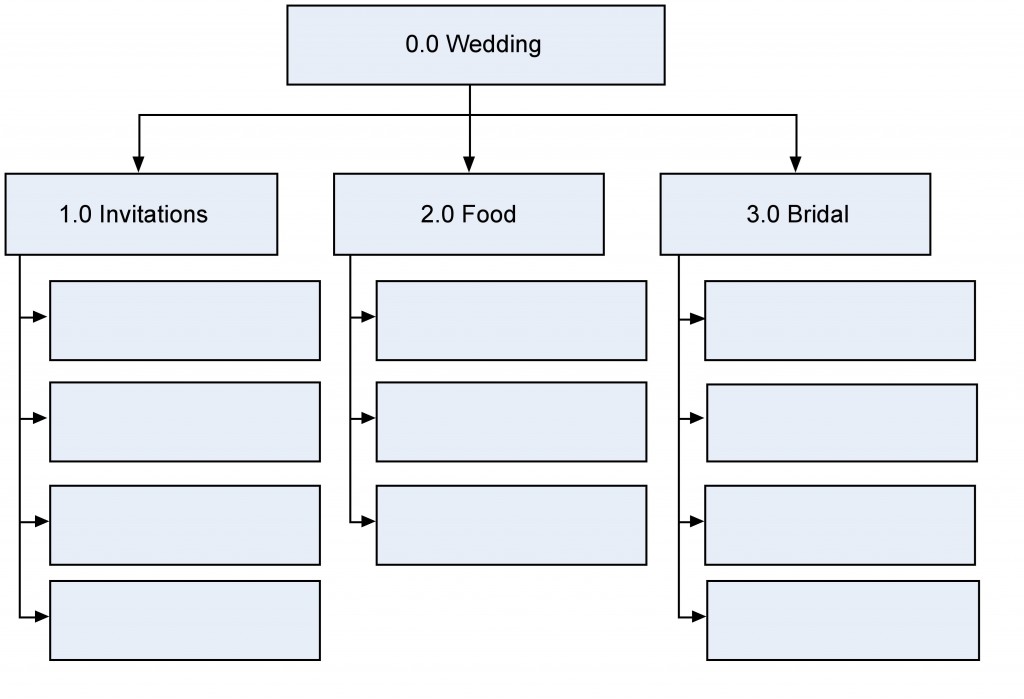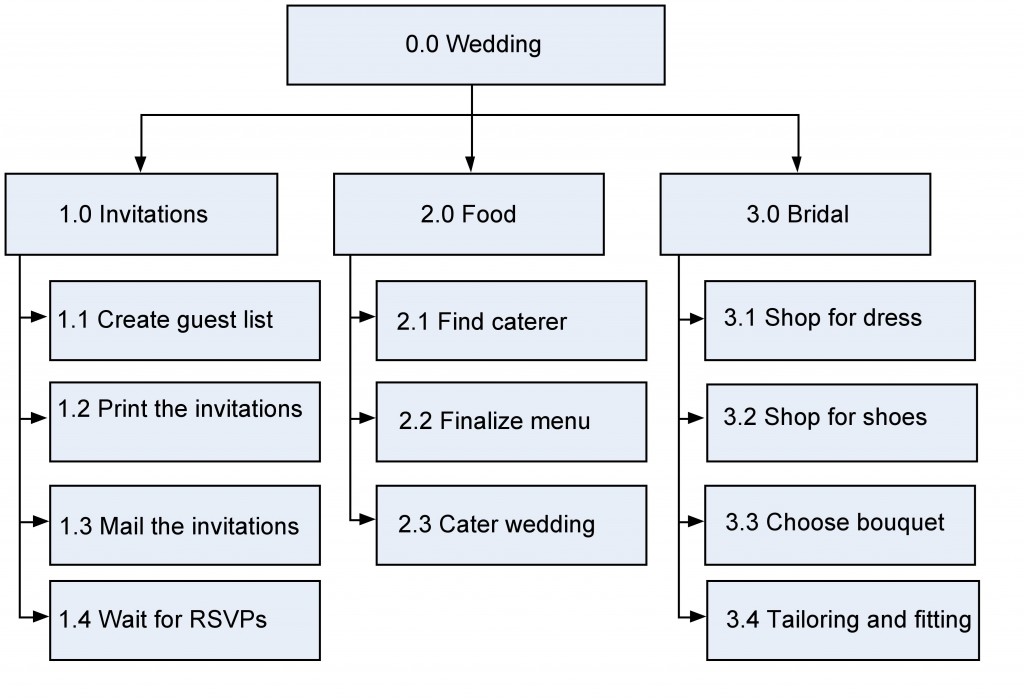40 Project Schedule Planning
Defining Activities
The activity definition process is a further breakdown of the work package elements of the WBS. It documents the specific activities needed to fulfill the deliverables detailed in the WBS. These activities are not the deliverables themselves but the individual units of work that must be completed to fulfill the deliverables. Activity definition uses everything we already know about the project to divide the work into activities that can be estimated. You might want to look at all the lessons learned from similar projects your company has done to get a good idea of what you need to do on the current one.
Expert judgment in the form of project team members with prior experience developing project scope statements and WBS can help you define activities. If you are asked to manage a project in a new domain, you might also use experts in that particular field to help define tasks so you can understand what activities are going to be involved. You may want to create an activity list and then have the expert review it and suggest changes. Alternatively, you could involve the expert from the very beginning and ask to have an activity definition conversation with him or her before even making your first draft of the list.
Sometimes you start a project without knowing a lot about the work that you’ll be doing later. Rolling-wave planning lets you plan and schedule only the portion that you know enough about to plan well. When you don’t know enough about a project, you can use placeholders for the unknown portions until you know more. These are extra items that are put at high levels in the WBS to allow you to plan for the unknown.
A Case Study
Susan and Steve have decided to tie the knot, but they don’t have much time to plan their wedding. They want the big day to be unforgettable. They want to invite many people and provide a great time. They’ve always dreamed of a June wedding, but it’s already January. Just thinking about all of the details involved is overwhelming. Susan has been dreaming of the big day since she was 12, but it seems that there’s so little time for all the tasks to be completed. When they were choosing the paper for the invitations, the couple realized that they needed help.
Steve: Don’t worry. My sister’s wedding planner was great. Let me give her a call. [Steve calls the wedding planner Sally.]
Wedding Planner: Hello, Susan and Steve.
Steve: We want everything to be perfect.
Susan: There is so much to do! Invitations, food, guests, and music.
Steve: Oh no, we haven’t even booked a place!
Susan: And it has to be done right. We can’t print the invitations until we have the menu planned. We can’t do the seating arrangements until we have the RSVPs. We aren’t sure what kind of band to get for the reception, or should it be a DJ? We’re just overwhelmed.
Steve: My sister said you really saved her wedding. I know she gave you over a year to plan. But I’ve always dreamed of a June wedding, and I’m not willing to give that up. I know it’s late, but Sally, can you help us?
Wedding Planner: Take it easy. I’ve got it under control. We’ve a lot of people and activities to get under control. You really should have called six months ago, but we’ll still make this wedding happen on time.
Much work has to be done before June. First, Sally figures out what work needs to be done. She starts to put together a to-do list:
- Invitations
- Flowers
- Wedding cake
- Dinner menu
- Band
Since many different people are involved in the making of the wedding, it takes much planning to coordinate all the work in the right order by the right people at the right time. Initially, Sally was worried that she didn’t have enough time to make sure that everything would be done properly. However, she knew that she had some powerful time management tools on her side when she took the job, and these tools would help her to synchronize all the required tasks.
To get started, Sally arranged all the activities in a work breakdown structure. The next exercise presents part of the WBS Sally made for the wedding.
WBS Exercise
Arrange the following activities into the WBS (Figure 10.1) to show how the work items decompose into activities.
- Shop for shoes
- Create guest list
- Have the tailoring and fitting done
- Shop for dress
- Find caterer
- Cater the wedding
- Wait for RSVPs
- Mail the invitations
- Finalize the menu
- Print the invitations
- Choose the bouquet


Image Descriptions
Figure 10.2 image description:
0.0 Wedding
- 1.0 Invitations
- 1.1 Create guest list
- 1.2 Wait for RSVPs
- 1.3 Mail the invitations
- 1.4 Print the invitations
- 2.0 Food
- 2.1 Find caterer
- 2.2 Cater the wedding
- 2.3 Finalize the menu
- 3.0 Bridal
- 3.1 Shop for shoes
- 3.2 Tailoring and fitting
- 3.3 Shop for dress
- 3.4 Choose the bouquet
Text Attributions
This chapter of Project Management is a derivative of the following texts:
- Project Management by Merrie Barron and Andrew Barron. © CC BY (Attribution).
- Gantt Chart by Wikipedia. © CC BY-SA (Attribution-ShareAlike).
- Planning a Project by OpenLearn Labspace. © CC BY-NC-SA (Attribution-NonCommercial-ShareAlike).
Media Attributions
- Wedding WBS Exercises by Barron & Barron Project Management for Scientists and Engineers © CC BY (Attribution)
- Wedding WBS Exercises Solution by Barron & Barron Project Management for Scientists and Engineers © CC BY (Attribution)
- FS Predecessor by Barron & Barron Project Management for Scientists and Engineers © CC BY (Attribution)
- SS Predecessor by Barron & Barron Project Management for Scientists and Engineers © CC BY (Attribution)
- FF Predecessor by Barron & Barron Project Management for Scientists and Engineers © CC BY (Attribution)
- WBS Lag by Barron & Barron Project Management for Scientists and Engineers © CC BY (Attribution)
- WBS Lead by Barron & Barron Project Management for Scientists and Engineers © CC BY (Attribution)
- Gantt Chart by Open University © CC BY-NC-SA (Attribution NonCommercial ShareAlike)
- WBS and Network Diagram by Barron & Barron Project Management for Scientists and Engineers © CC BY (Attribution)
- AON Diagram by Barron & Barron Project Management for Scientists and Engineers © CC BY (Attribution)
- Activity arrow diagram by Barron & Barron Project Management for Scientists and Engineers © CC BY (Attribution)
- Critical Path Diagram by Open University © CC BY-NC-SA (Attribution NonCommercial ShareAlike)

